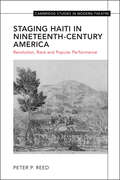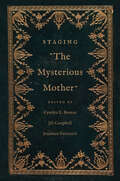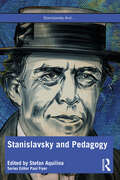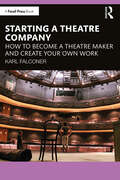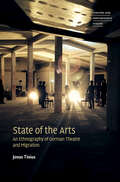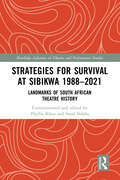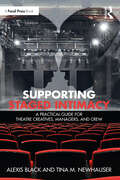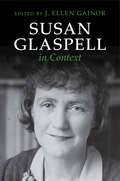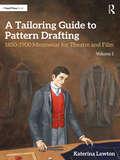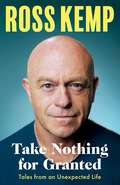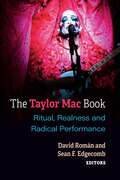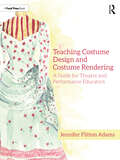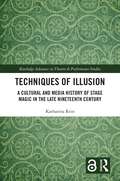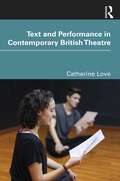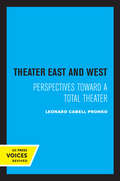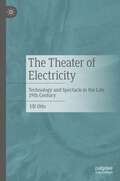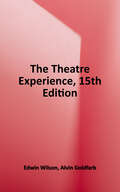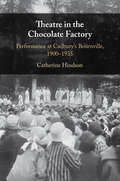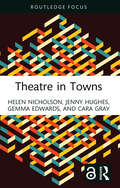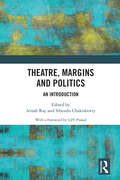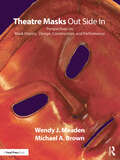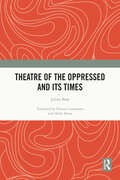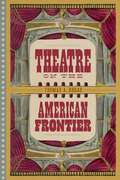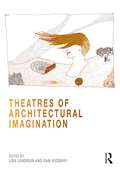- Table View
- List View
Staging Haiti in Nineteenth-Century America: Revolution, Race and Popular Performance (Cambridge Studies in Modern Theatre)
by Peter ReedAmerican culture maintained a complicated relationship with Haiti from its revolutionary beginnings onward. In this study, Peter P. Reed reveals how Americans embodied and re-enacted their connections to Haiti through a wide array of performance forms. In the wake of Haiti's slave revolts in the 1790s, generations of actors, theatre professionals, spectators, and commentators looked to Haiti as a source of both inspiring freedom and vexing disorder. French colonial refugees, university students, Black theatre stars, blackface minstrels, abolitionists, and even writers such as Herman Melville all reinvented and restaged Haiti in distinctive ways. Reed demonstrates how Haiti's example of Black freedom and national independence helped redefine American popular culture, as actors and audiences repeatedly invoked and suppressed Haiti's revolutionary narratives, characters, and themes. Ultimately, Haiti shaped generations of performances, transforming America's understandings of race, power, freedom, and violence in ways that still reverberate today.
Staging "The Mysterious Mother" (The Lewis Walpole Series in Eighteenth-Century Culture and History)
by Cynthia E. Roman, Jill Campbell, and Jonathan KramnickThe first book-length study of Horace Walpole&’s scandalous The Mysterious Mother, including critical essays, an abridged script, and a facsimile edition Horace Walpole&’s five-act tragedy The Mysterious Mother (1768), a sensational tale of incest and intrigue, was initially circulated only among the author&’s friends. Walpole never permitted it to be performed during his lifetime except as a private theatrical. He described his play as a &“delicious entertainment for the closet&” and claimed that he &“did not think it would do for the stage.&” Yet the essays in this volume trace a history of private readings, amateur theatricals, and even early public performances, demonstrating that the play was read and performed more than Walpole&’s protests suggest. Exploring a wide variety of topics—including the play&’s crypto-Catholicism, its treatments of incest, guilt, motherhood, orphans, and scientific spectacle, and the complex relations between print and performance—the essays demonstrate the rich relevance of The Mysterious Mother to current critical discussions. The volume includes the proceedings of a mini-conference hosted at Yale University in 2018 on the occasion of a staged reading of the play. Also included are the director&’s reflections, an abridged script, a facsimile of Walpole&’s own copy of the full-length play, and reproductions of the illustrations he commissioned from Lady Diana Beauclerk.
Stanislavsky and Pedagogy (Stanislavsky And...)
by Stefan AquilinaStanislavsky and Pedagogy explores current thinking around the pedagogical implications of Stanislavsky’s work. The volume depicts the voices of a number of practitioners, teachers, and scholars who are themselves journeying with Stanislavsky, and who in his work find a potent instigator for their own pedagogical practice and study. This book outlines instances in which updated interpretations of Stanislavsky’s pedagogy are adapted to cater for contemporary needs and scenarios. These include the theatre industry, new digital technologies, the need to develop playfulness, application to a broad repertoire, performance as pedagogy, university managerialism, and interdisciplinary crossovers with dance and opera. The pedagogies that emerge from these case-studies are marked by fluidity and non-fixity and help to underscore the malleability of Stanislavsky’s system. Stanislavsky And... is a series of multi-perspectival collections that bring the enduring legacy of Stanislavskian actor training into the spotlight of contemporary performance culture, making them ideal for students, teachers, and scholars of acting, actor training, and directing.
Starting a Theatre Company: How to Become a Theatre Maker and Create Your Own Work
by Karl FalconerExploring everything from company incorporation and marketing, to legal, finance and festivals, Starting a Theatre Company is the complete guide to running a low-to-no budget or student theatre company. Written by an experienced theatre practitioner and featuring on-the-ground advice, this book covers all aspects of starting a theatre company with limited resources, including how to become a company, finding talent, defining a style, roles and responsibilities, building an audience, marketing, the logistics of a production, legalities, funding, and productions at festivals and beyond. The book also includes a chapter on being a sustainable company, and how to create a mindset that will lead to positive artistic creation. Each chapter contains a list of further resources, key terms and helpful tasks designed to support the reader through all of the steps necessary to thrive as a new organisation. An eResource page contains links to a wide range of industry created templates, guidance and interviews, making it even easier for you to get up and running as simply as possible. Starting a Theatre Company targets Theatre and Performance students interested in building their own theatre companies. This book will also be invaluable to independent producers and theatre makers.
State of the Arts: An Ethnography of German Theatre and Migration (Theatre and Performance Theory)
by Jonas TiniusThis is a bold and wide-ranging account of the unique German public theatre system through the prism of a migrant artistic institution in the western post-industrial Ruhr region. State of the Arts analyses how artistic traditions have responded to social change, racism, and cosmopolitan anxieties and recounts how critical contemporary cultural production positions itself in relation to the tumultuous history of German state patronage, difficult heritage, and self-cultivation through the arts. Jonas Tinius' fieldwork with professional actors, directors, cultural policy makers, and activists unravels how they constitute theatre as a site for extra-ordinary ethical conduct and how they grapple with the pervasive German cultural tradition of Bildung, or self-cultivation through the arts. Tinius shows how anthropological methods provide a way to understand the entanglement of cultural policy, institution-building, and subject-formation. An ambitious and interdisciplinary study, the work demonstrates the crucial role of artistic intellectuals in society.
Strategies for Survival at SIBIKWA 1988 – 2021: Landmarks of South African Theatre History (Routledge Advances in Theatre & Performance Studies)
by Phyllis Klotz Smal NdabaThis book provides an engaging and contextualised insight into a South African township-based arts centre that has survived the vicissitudes of steady militarisation in townships during some of the worst years of apartheid as well as the exhilaration of a new democratic policy while attempting to circumnavigate different policies and funding dispensations. Sibikwa provides arts centres across the world and especially those in decolonising countries with strategies for survival in tumultuous times. This multi-disciplinary book maps and co-ordinates wider historical, political, and social contextual concerns and events with matters specific to a community-based east of Johannesburg and provides an exploration and analysis by experts of authentic theatre-making and performance, dance, indigenous music, arts in education and NGO governance. It has contemporary significance and raises important questions regarding inclusivity and transformation, the function and future of arts centres, community-based applied arts practices, creativity, and international partnerships. This study will be of great interest to students and scholars in theatre and performance, indigenous music, dance, and South African history.
Supporting Staged Intimacy: A Practical Guide for Theatre Creatives, Managers, and Crew
by Alexis Black Tina M. NewhauserSupporting Staged Intimacy: A Practical Guide for Theatre Creatives, Managers, and Crew examines the relationship between staged intimacy, intimacy direction, and those supporting the process during pre-production, rehearsal, and performance. First, this book addresses challenges and trends in staging intimacy, helping backstage and offstage theatre artists recognize the problematic approaches and culture that led to the emerging field of intimacy direction. This text will then provide tools and recommended practices for supporting the creation and maintaining of staged intimacy, enabling team members to enact contemporary protocols concerning advocacy and agency. Finally, this book will educate and empower readers with the necessary skills to prompt change; by providing modern techniques, essential workplace protocols, and achievable action items, this book will transform the way theatre designers, managers, crew, and other creative team members engage with theatrical consent. Supporting Staged Intimacy is written for every pre-professional and professional artist working behind the scenes who wish to better support consensual workplaces, physically intimate stories, and the individuals telling those stories.
Susan Glaspell in Context (Literature in Context)
by J. Ellen GainorSusan Glaspell in Context provides new, accessible, and informative essays by leading international scholars and artists on Pulitzer Prize winner Susan Glaspell's life, career development, writing, and ongoing global creative impact. The collection features wide-ranging discussions of Glaspell's fiction, plays, and non-fiction in both historical and contemporary critical contexts, and demonstrates the significance of Glaspell's writing and other professional activities to a range of academic disciplines and artistic engagements. The volume also includes the first analyses of six previously unknown Glaspell short stories, as well as interviews with contemporary stage and film artists who have produced Glaspell's works or adapted them for audiences worldwide. Organized around key locations, influences, and phases in Glaspell's career, as well as core methodological and pedagogical approaches to her work, the collection's thirty-one essays place Glaspell in historical, geographical, political, cultural, and creative contexts of value to students, scholars, teachers, and artists alike.
A Tailoring Guide to Pattern Drafting: 1850-1900 Menswear for Theatre and Film, Volume 1
by Katerina LawtonA Tailoring Guide to Pattern Drafting offers pattern drafting instructions for men’s most popular tailored garment styles from 1850 to 1900, used in theatres and film productions today. The book features a wide range of 19th-century garments, providing information and detailed instructions on the frock coat, morning coat, lounge jacket, smoking jacket, shirt, waistcoats, trousers and long-riding breeches. It includes a brief history of each garment, accompanied by colourful illustrations and easy-to-follow instruction to draft historical 19th-century silhouettes for modern performances. The book features: A brief history of each garment, accompanied by full-colour illustrations. Modern step-by-step instructions with clear diagrams to draft 19th-century menswear. Instructions incorporating both the imperial and metric systems. Recommendations on choosing the appropriate modern-day equivalent fabric. Recommendations on the quantity of the fabric. Recommendations on the button size to make the garment appear more authentic. A table of Dress Code Ethics for Gentlemen from 1850 to 1900. Descriptions and visual information on how to take accurate measurements. Photographs of costumes and images of the 19th-century Carte de Visite for visual support. A Tailoring Guide to Pattern Drafting is intended for anyone with a desire to learn or refine their costume-cutting skills for theatre and film production. The book is aimed at undergraduate and graduate students, tutors and both amateur and professional makers interested in the subject. To access the author’s YouTube channel, featuring 130 step-by-step lessons to make a 19th-century Morning Coat using classical tailoring techniques, visit www.routledge.com/9780367265335.
Take Nothing For Granted: Tales from an Unexpected Life
by Ross Kemp'These are the stories of some of the things that have happened to me: the funny things, the scary things, the exciting things; the things that have made me who I am. I don't want to start at the beginning and tell them in chronological order because that's not the way my brain works. And this certainly isn't going to be one of those books of life lessons . . .'I've always been passionate about finding and telling stories. And now, for the first time, here are mine.'Famous for his portrayal of TV hardman Grant Mitchell and as the maker of documentaries exploring the most dangerous people and places on the planet, BAFTA-winning Ross Kemp is one of the UK's best known TV stars. Here, Ross shares tales from his remarkable life.From his childhood in Essex, where he used to pretend the woods behind his house were the Amazon rainforest, to finding himself travelling through the real thing thirty years later, Ross's life has taken many twists and turns. Through it all there's been no plan, no roadmap, no strategy. Ross has gone from one wild adventure to the next, and never quite felt like he's fitted in anywhere.From getting lost at sea to setting a sacred island on fire, auditioning for his part on EastEnders to filming in active war zones across the world, these are the heart-warming, hilarious and hard-hitting stories of some of the unexpected adventures that have happened along the way.Warm, energetic and endlessly entertaining, it is a fascinating snapshot of a life lived to the full.
Take Nothing For Granted: Tales from an Unexpected Life
by Ross Kemp'These are the stories of some of the things that have happened to me: the funny things, the scary things, the exciting things; the things that have made me who I am. I don't want to start at the beginning and tell them in chronological order because that's not the way my brain works. And this certainly isn't going to be one of those books of life lessons . . .'I've always been passionate about finding and telling stories. And now, for the first time, here are mine.'Famous for his portrayal of TV hardman Grant Mitchell and as the maker of documentaries exploring the most dangerous people and places on the planet, BAFTA-winning Ross Kemp is one of the UK's best known TV stars. Here, Ross shares tales from his remarkable life.From his childhood in Essex, where he used to pretend the woods behind his house were the Amazon rainforest, to finding himself travelling through the real thing thirty years later, Ross's life has taken many twists and turns. Through it all there's been no plan, no roadmap, no strategy. Ross has gone from one wild adventure to the next, and never quite felt like he's fitted in anywhere.From getting lost at sea to setting a sacred island on fire, auditioning for his part on EastEnders to filming in active war zones across the world, these are the heart-warming, hilarious and hard-hitting stories of some of the unexpected adventures that have happened along the way.Warm, energetic and endlessly entertaining, it is a fascinating snapshot of a life lived to the full.
The Taylor Mac Book: Ritual, Realness and Radical Performance (Triangulations: Lesbian/Gay/Queer Theater/Drama/Performance)
by David Roman Sean EdgecombThis is the first book to dedicate critical attention to the work of influential theater-maker Taylor Mac. Mac is particularly celebrated for the historic performance event A 24-Decade History of Popular Music, in which Mac, in fantastical costumes designed by collaborator Machine Dazzle, sang the history of the United States for 24 straight hours in October 2016. The MacArthur Foundation soon thereafter awarded their “genius” award to a “writer, director, actor, singer, and performance artist whose fearlessly experimental works dramatize the power of theater as a space for building community . . . [and who] interacts with the audience to inspire a reconsideration of assumptions about gender, identity, ethnicity, and performance itself.” Featuring essays, interviews, and commentaries by noted critics and artists, the volume examines the vastness of Mac’s theatrical imagination, the singularity of their voice, the inclusiveness of their cultural insights and critiques, and the creativity they display through stylistic and formal qualities and the unorthodoxies of their personal and professional trajectories. Contributors consider the range of Mac’s career as a playwright, performer, actor, and singer, expanding and enriching the conversation on this much-celebrated and deeply resonant body of work.
Teaching Costume Design and Costume Rendering: A Guide for Theatre and Performance Educators
by Jennifer Flitton AdamsTeaching Costume Design and Costume Rendering: A Guide for Theatre and Performance Educators clarifies the teaching process for Costume Design and Costume Rendering courses and offers a clear and tested path to success in the classroom. Drawing on the knowledge and experience of the author’s twenty-five years of teaching as well as many decades of work by multiple other educators, this book provides a clear roadmap for teaching these two popular Theatre courses. It includes information on pedagogical theory, creating syllabi, preparing and structuring classes, crafting lectures, and analyzing students’ work, with a heavy focus on specific teaching projects that have been proven to work in the classroom. All aspects of teaching costume design and rendering are considered, including body awareness, cultural sensitivities, script analysis, elements and principles of design, psychology of dress, choosing fabrics, period styling, and requirements of dance costumes. Included in the appendices are sample syllabi, and additional reading and research resources. Teaching Costume Design and Costume Rendering is a guide for theatre and performance educators ranging from secondary education to undergraduate programs and graduate studies. It is a valuable resource both for costume educators approaching costume design and rendering classes for the first time and for experienced instructors looking for new material for these courses.
Techniques of Illusion: A Cultural and Media History of Stage Magic in the Late Nineteenth Century (Routledge Advances in Theatre & Performance Studies)
by Katharina ReinThis book explores stage conjuring during its “golden age,” from about 1860 to 1910. This study provides close readings highlighting four paradigmatic illusions of the time that stand in for different kinds of illusions typical of stage magic in the “golden age” and analyses them within their cultural and media-historical context: “Pepper’s Ghost,” the archetypical mirror illusion; “The Vanishing Lady,” staging a teleportation in a time of a dizzying acceleration of transport; “the levitation,” simulating weightlessness with the help of an extended steel machinery; and “The Second Sight,” a mind-reading illusion using up-to-date communication technologies. These close readings are completed by writings focusing on visual media and expanding the scope backwards and forwards in time, roughly to 1800 and to 2000. This exploration will be of great interest to students and scholars in theatre and performance studies.
Text and Performance in Contemporary British Theatre
by Catherine LoveText and Performance in Contemporary British Theatre interrogates the paradoxical nature of theatre texts, which have been understood both as separate literary objects in their own right and as material for performance. Drawing on analysis of contemporary practitioners who are working creatively with text, the book re-examines the relationship between text and performance within the specific context of British theatre. The chapters discuss a wide range of theatre-makers creating work in the UK from the 1990s onwards, from playwrights like Tim Crouch and Jasmine Lee-Jones to companies including Action Hero and RashDash. In doing so, the book addresses issues such as theatrical authorship, artistic intention, and the apparent incompleteness of plays as both written and performed phenomena. Text and Performance in Contemporary British Theatre also explores the implications of changing technologies of page and stage, analysing the impact of recent developments in theatre-making, editing, and publishing on the status of the theatre text. Written for scholars, students, and practitioners alike, Text and Performance in Contemporary British Theatre provides an original perspective on one of the most enduring problems to occupy theatre practice and scholarship.
Theater East and West: Perspectives Toward a Total Theater
by Leonard C. PronkoThis title is part of UC Press's Voices Revived program, which commemorates University of California Press’s mission to seek out and cultivate the brightest minds and give them voice, reach, and impact. Drawing on a backlist dating to 1893, Voices Revived makes high-quality, peer-reviewed scholarship accessible once again using print-on-demand technology. This title was originally published in 1967.
The Theater of Electricity: Technology and Spectacle in the Late 19th Century
by Ulf OttoSince the 1880s, electrical energies started circulating in European theaters, generated from fossil fuels in urban power plants. A mysterious force, which was still traded as romantic life force by some and for others had already come to stand in for progress, entered performance venues. Engineering knowledge, control techniques and supply chains changed fundamentally how theater was made and thought of. The mechanical image machine from Renaissance and Baroque times was transformed into a thermodynamic engine. Modern theater turned out to be electrified theater. – Retracing what happened backstage before the Avantgarde took to the front stage, this book proposes to write the genealogy of theaters modernity as a cultural history of theater technology.
The Theatre Experience
by Edwin Wilson Alvin GoldfarbThe Theatre Experience, 15e prepares students to be well-informed, well-prepared theatre audience members. With an audience-centered narrative that engages today’s students, a vivid photo program that brings concepts to life, and features that teach and encourage a variety of skill sets, students master core concepts and learn to think critically about theatre and the world around them. As a result, students are better prepared for class and better prepared for theatregoing. The textbook is noted for its lively writing style and for helping students recognize how theatre relates to our everyday lives.
Theatre in the Chocolate Factory: Performance at Cadbury's Bournville, 1900–1935
by Catherine HindsonProviding a new way of thinking about industrialism and its history through the lens of one of Britain's most recognisable heritage brands, Catherine Hindson explores the creativity that was at the heart of Cadbury's operation in the early twentieth century. Guided by Quaker Capitalism, employees at Bournville took part in recreational and educational activities, enabling imagination to flourish. Amidst this pattern of work and play arose the vibrant phenomenon that was factory theatre, with performances and productions involving tens of thousands of employees as performers and spectators. Home-grown Bournville casts and audiences were supplemented by performers, civic leaders, playwrights, academics, town planners, and celebrities, interweaving industrialists with the city's theatrical and visual arts as well as national entertainment cultures. This interdisciplinary study uncovers the stories of Bournville's theatre and the employees who made it, considering ground-breaking approaches to mental and physical health and education.
Theatre in Towns
by Helen Nicholson Jenny Hughes Gemma Edwards Cara GrayTheatre in Towns offers a contemporary perspective on the role of theatre in the cultural life of towns in England. Exploring volunteer-led, professional and community theatres, this book investigates the rich and diverse ways that theatres in towns serve their locality, negotiate their civic role, participate in networks of mutual aid and exchange, and connect audiences beyond their geographical borders. With a geographical focus on post-industrial, seaside, commuter and market towns in England, the book opens questions about how theatre shapes the narratives of town life, and how localism, networks and partnerships across and between towns contribute to living sustainably. Each chapter is critically and historically informed, drawing on original research in towns, including visits to performances and many conversations with townspeople, from theatre-makers, performers, set-builders, front-of-house volunteers, to audience members and civic leaders. Theatre in Towns asks urgent questions about how the relationships between towns and theatres can be redefined in new and equitable ways in the future. Theatre in Towns brings new research to scholars and students of theatre studies, cultural geography, cultural and social policy and political sociology. It will also interest artists, policy-makers and researchers wanting to develop their own and others’ understanding of the value of active theatre cultures in towns. The Open Access version of this book, available at www.taylorfrancis.com, has been made available under a Creative Commons Attribution-Non Commercial-No Derivatives 4.0 license.
Theatre, Margins and Politics: An Introduction
by Arnab Ray Sibendu ChakrabortyThis book interrogates the relationship of theatre and the dialectics of centre and the margins. It looks into the exciting world of performance to examine how theatre as an art form is perfectly placed to both perform and critique complex relations of power, politics and culture. The volume looks into how drama has historically served as a stage for expressing and showcasing prevalent social, historical, and cultural contexts from which it has emerged or intends to critique. Including a wide range of performative practices like Dalit theatre, Australian Aboriginal theatre, Western realism and Yoruba theatre, it explores varied lived experiences of people, and voices of subversion, subalternity, resistance and transformation. The book scrutinizes the strategies of representation enunciated through textuality, theatricality and performance in these works and the politics they are inextricably linked with. This book will be of interest and use to scholars, researchers, and students of theatre and performance studies, postcolonial studies, race and inequality studies, gender studies, and culture studies.
Theatre Masks Out Side In: Perspectives on Mask History, Design, Construction, and Performance
by Wendy J. Meaden Michael A. BrownTheatre Masks Out Side In examines masks from different angles and perspectives, combining the history, design, construction, and use of masks into one beautifully illustrated resource. Each chapter includes key information about an element of mask study: history and uses, theatre traditions, practical principles for directing, performing exercises, design considerations, mask-making techniques, and considering makeup as mask. Artist interviews, theatre company profiles, and hundreds of images provide insight into the variety of mask styles and performance applications. Project suggestions, discussion questions, useful worksheets, creative prompts, and resources for sourcing masks are included to inspire further exploration. Theatre Masks Out Side In is designed with the beginning theatre maker in mind, as well as prop makers, costume designers and technicians, and actors learning to use masks in performance.
Theatre of the Oppressed and its Times
by Julian BoalPolitical theatre, like any kind of political action, can only be judged in relation to the political moment in which it tries to intervene. Theatre of the Oppressed (TO) was created to fight against dictatorship and an extremely centralized conception of politics. How does it function now, in a time of social media and so-called participatory democracies? Providing an in-depth account of the political and cultural context in which TO emerged, this book asks: How do contemporary understandings of concepts like oppression, representation, participation, and emancipation shape TO today? Highlighting the pitfalls of reducing oppression to one-to-one relationships, the book proposes a version of Forum Theatre dramaturgy that portrays oppression as a defining structure of societies. The author also shares specific examples of movements and other organizations that use Theatre of the Oppressed to construct themselves. Theatre of the Oppressed and Its Times is an essential text for practitioners and scholars of TO, applied theatre practitioners, students, and anyone interested in how theatre can concretely assist in the transformation of the world.
Theatre on the American Frontier
by Thomas A. BogarFor two centuries, nearly all historical accounts of American theatre have focused on New York, Boston, and Philadelphia. As a result, the story of theatre on the frontier consists primarily of regional studies with limited scope. Thomas A. Bogar’s Theatre on the American Frontier provides an overdue, balanced treatment of the accomplishments of the troupes working in the trans-Appalachian West.From its origins in late eighteenth-century Pittsburgh, New Orleans, and Louisville, frontier theatre grew by the close of the nineteenth century to encompass more than a dozen centers of vibrant theatrical activity. Audiences—mainly pioneers struggling with the hardships of establishing a life in the backcountry—enjoyed thrilling melodramas, the comedies of George Colman the Younger and John O’Keeffe, and even the tragedies of William Shakespeare. Theatre companies that ventured into this challenging and unfamiliar territory did so with a combination of daring and determination. Bogar’s comprehensive study brings this neglected history into the spotlight, cementing these figures and their theatrical productions and practices in their rightful place.
Theatres of Architectural Imagination
by Lisa LandrumThis volume explores connections between architecture and theatre, and encourages imagination in the design of buildings and social spaces. Imagination is arguably the architect’s most crucial capacity, underpinning memory, invention, and compassion. No simple power of the mind, architectural imagination is deeply embodied, social, and situational. Its performative potential and holistic scope may be best understood through the model of theatre. Theatres of Architectural Imagination examines the fertile relationship between theatre and architecture with essays, interviews and entr’actes arranged in three sections: Bodies, Settings, and (Inter)Actions. Contributions explore a global spectrum of examples and contexts, from ancient Rome and Renaissance Italy to modern Europe, North America, India, Iran, and Japan. Topics include the central role of the human body in design; the city as a place of political drama, protest, and phenomenal play; and world-making through language, gesture, and myth. Chapters also consider sacred and magical functions of theatre in Balinese and Persian settings; eccentric experiments at the Bauhaus and 1970 Osaka World Expo; and ecological action and collective healing amid contemporary climate chaos. Inspired by architect and educator Marco Frascari, the book performs as a Janus-like memory theatre, recalling and projecting the architect’s perennial task of reimagining a more meaningful world. This collection will delight and provoke thinkers and makers in theatrical arts and built environment disciplines, especially architecture, landscape, and urban design.
